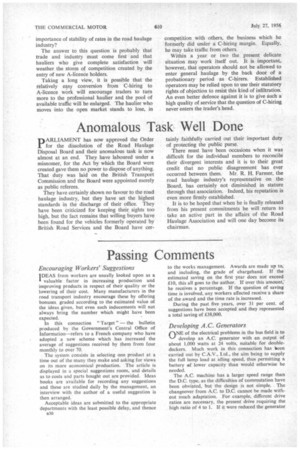Passing Comments
Page 36

Page 37

If you've noticed an error in this article please click here to report it so we can fix it.
Encouraging Workers' Suggestions
IDEAS from workers are usually looked upon as a I valuable factor in increasing production and improving products in respect of their quality or the lowering of their cost. Many manufacturers in the road transport industry encourage these by offering bonuses, graded according to the estimated value of the ideas given, but even such inducements will not always bring the number which might have been expected.
In this connection "Target " — the bulletin produced by the Government's Central Office of Information—refers to a French company who have adopted a new scheme which has increased the average of suggestions received by them from four monthly to over 70.
The system consists in selecting one product at a time out of the many they make and asking for views on its more economical production. The article is displayed in a special suggestions room, and details as to costs and parts bought out are provided. Ideas books are available for recording any suggestions and these are studied daily by the management, an interview with the author of a useful suggestion is then arranged.
Acceptable ideas are submitted to the appropriate departments with the least possible delay, and thence 830 to the works management. Awards are made up to; and including, the grade of chargehand. If the estimated saving on the first year does not exceed £10, this all goes to the author. If over this amount,' he receives a percentage. If the question of saving time is involved, any workers affected receive a share of the award and the time rate is increased.
During the past five years, over 31 per cent, of suggestions have been accepted and they represented a total saving of £38,000.
Developing A .C. Generators
("NE of the electrical problems in the bus field is to ".-1 develop an A.C. generator with an output of about 1,000 watts at 24 volts, suitable for doubledeckers. Much work in this connection has been carried out by C.A.V., Ltd., the aim being to supply the full lamp load at idling speed, thus permitting a battery of lower capacity than would otherwise be needed.
The A.C. machine has a larger speed range than the D.C. type, as the difficulties of commutation have been obviated, but the design is not simple. The changeover from A.C. to D.C. cannot be made without much adaptation. For example, different drive ratios arc necessary, the present drive requiring the high ratio of 4 to 1. If it were reduced the generator
would have to be much larger to provide the same output at the reduced speed. This company intend also to develop a larger model of some 1,500 W. to cover the total load required for heating, ventilating, etc., in overseas vehicles.
Fluorescent lighting is another difficulty, this could be run direct from the A.C. system but the A.C. is available only when the engine is running and another supply is needed when it is at rest. Lighting could then be by ordinary lamps or fluorescent tubes operated through a vibrator.
Better Synchronization Needed?
rO-OPERATION in timing between the railways
and certain bus operators, as it concerns the arrival and departure of trains, is not always too happy. Whether by accident or intent, passengers by train who wish to travel to their homes in local buses, on arriving at. the station, frequently see only partially laden vehicles departing just before they are able to reach them, or possibly a few may scramble on but the remainder are left.
Other buses may be so timed that they arrive at stations almost simultaneously with the departure of trains, or so long before these go that long waits ensue. To wait, say, 10 min. in bad weather and sit a further 10 min. before the vehicle moves off, and all for a comparatively short ride, cause annoyance and a feeling of frustration, whilst operators may lose by the more energetic electing to walk. Moreover, conductors and drivers are sometimes blamed for such occurrences, for passengers may not realize that bus working is often to a tight schedule, involving penalties for being early or late.
Commercial Enterprise at Hoeford
JT was quite an evening at Hoeford, near Fareham, when Harold Radford and Co., Ltd., of Melton Court, South Kensington, London, S.W.7, who also own a coachbuilding works and repair depot at 124 King Street, Hammersmith, W.6, opened their first showroom, service and petrol station outside London. The parent company, the Provincial Traction Co., Ltd., own the Gosport and Fareham Omnibus Co.,
and it was Mr. Ortne-White, manager and engineer of that company, who was largely responsible for the design of the new premises—The Fountain Garage.
At Hoeford, the Radford concern have been appointed distributors in Hampshire and the Isle of Wight for Guy vehicles, as well as agents for the Ford commercial range. Here, too, will be a wellequipped service station for commercial vehicles. The main building has a floor area of 900 sq. yd. and a roof of •the girder-rafter type without intermediate cross-trusses.
The many guests were welcomed by Mr. Harold Radford, who expressed his high opinion of Guy products, a number of which was on display.












































































































